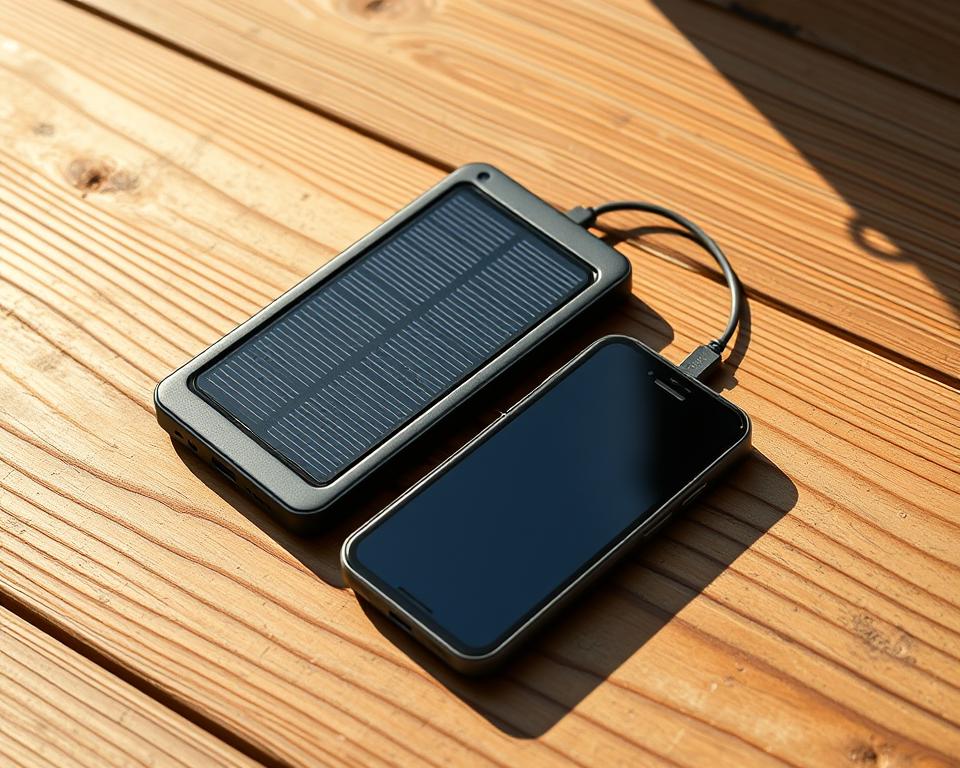Advertisements
Have you ever experienced your phone running out of battery when you least expected it? This problem is common, especially in Mexico, where we spend hours online. The good news is that there are sustainable alternatives to keep your devices running.
The solar panels offer a practical and ecological solution. With a solar chargerYou can recharge your device anywhere, without relying on power outlets. It's ideal for travel, outdoor activities, or emergencies.
Advertisements
In addition to being portable, these devices reduce your environmental footprint. renewable energies are gaining popularity, and this technology is advancing rapidly. By 2024, you'll find more efficient and affordable options.
Want to know how they work and which one to choose? Read on to discover the best options available this year.
Advertisements
What is a solar-powered phone and how can it help you?
Solar technology is revolutionizing how we keep our equipment connected. These devices use solar panels to transform light into electricity, offering freedom and sustainability.
Advantages of using solar energy for your phone
Here are the reasons why you should consider a solar charger:
- Autonomy: Ideal for remote areas without access to the electrical grid.
- Saving: Reduces long-term costs by eliminating dependence on plugs.
- Caring for the environment: Reduces CO₂ emissions compared to traditional methods.
- Compatibility: Works with any USB device, from phones to tablets.
- Endurance: Designed to withstand rain, dust and extreme temperatures.
Is it viable in Mexico?
Mexico receives an average of 5.5 kWh/m² of daily solar irradiation, according to recent studies. This makes it perfect for taking advantage of this technology.
In desert regions like Sonora, chargers reach their maximum powerEven during the rainy season, they store enough energy for later use.
One example is rural communities, where these solutions have improved connectivity without expensive infrastructure.
How solar charging for mobile phones works
Did you know you can charge your device using only daylight? solar chargers They convert lightning into electricity using photovoltaic panels. This technology is ideal for those seeking energy independence.
Is direct sunlight needed?
The premium models They work even in indirect light, although they take longer to complete the burdenLight intensity, panel angle, and temperature affect its performance.
For best results:
- Place the device in a clear area.
- Avoid shadows that reduce efficiency.
- Clean the dust panels regularly.
Charging time vs. traditional chargers
While a conventional USB charge takes 2 hours, solar charging can take up to 12 hours. However, their advantage is that portability and autonomy.
Key factors influencing:
- Panel Watts: The higher the power, the shorter the time.
- External battery: Accelerates the process by storing energy.
- Weather conditions: Cloudy days reduce speed.
With strategic use, these chargers They're a practical solution for emergencies or long trips. Ready to try them?
Types of solar chargers for your phone
Discover how the different models of solar chargers adapt to your needs. From storage options to ready-to-use designs, each type offers unique advantages.
With built-in battery: power when you need it
These devices, such as the RAVPower RP-PC008, include a external battery up to 32,000mAh. They are perfect for:
- Long trips: They store energy for multiple recharges.
- Emergencies: They work even without direct sunlight.
- Outdoor use: Water resistant (IP67 certification).
For immediate use: lightness and practicality
Without external batteryThese chargers are ultra-portable. Ideal for hiking or days out in the city where sunlight is available. They usually have solar panels foldable for greater comfort.
When choosing, you have innovations such as:
- Cooling systems to prevent overheating.
- Wireless connection in premium models.
- High-efficiency panels that capture more light.
The best part? You can select based on the number of devices you use and the weather conditions in your area. place favorite.
The best solar chargers for mobile phones in 2024
Looking for energy independence? These models are leading the market this year. They combine power, design, and functionality to suit any lifestyle. From extreme adventures to everyday use in the city, you'll find the best option here.
Suaoki 20W: Power and resistance
Ideal for expeditions, the Suaoki 20W It stands out for its battery 34,000mAh and a 25% higher efficiency. It's perfect for:
- Long trips: Recharge up to 10 phones on a single charge.
- Extreme climates: Rain and dust resistant (IP65).
"I used it in the Sierra Madre Oriental and it kept all our devices running for 5 days straight."
OLEBR Q90: Lightweight and multifunctional
At just 450g, this solar charger includes a USB fan to prevent overheating. Its weight Lightweight and foldable design make it ideal for backpacking.
- Ability: 24,000mAh.
- Extra: : 3 USB ports for simultaneous charging.
RAVPower RP-PC008: iSmart Technology
The iSmart technology Automatically detects the connected device to optimize speed. Perfect for urban use in Mexico City, where sunlight is abundant.
- Innovation: Firmware updates to improve performance.
- Durability: Monocrystalline silicon panel.
| Model | Capacity (mAh) | Weight | Ports | Price (MXN) |
|---|---|---|---|---|
| Suaoki 20W | 34,000 | 800g | 2 USB + 1 Type-C | 1,499 |
| OLEBR Q90 | 24,000 | 450g | 3 USB | 1,199 |
| RAVPower RP-PC008 | 32,000 | 600g | 2 USB + 1 Type-C | 1,799 |

Maintenance tipsClean the panels with a soft cloth every two weeks. During the rainy season, store them in a dry place. This will extend their lifespan and maintain their efficiency.
Are there already mobile phones with integrated solar panels?
Innovation in sustainable devices is advancing faster than you might imagine. Brands like Xiaomi and Motorola are already testing functional prototypes with solar panels built-in. These devices promise to revolutionize how we use technology.
Trend-setting projects
Xiaomi surprised with its patent for a solar rear display. It captures light even when the device is face down. Motorola, for its part, launched the Moto Z module with 2,200mAh of solar capacity.
Chronological evolution:
- 2017: First functional prototype (efficiency of the 5%)
- 2022: Flexible materials for bending panels
- 2024: Integration into transparent OLED displays
Challenges and next steps
Currently, challenges include:
- Additional thickness (up to 3mm more than standard models)
- Low efficiency indoors (less than 15%)
- High production costs
By 2025-2030, it is expected:
- 7-day autonomy with solar charging
- Reception of artificial light in closed spaces
- Connection with wearables such as smartwatches
| Model | Panel type | Additional autonomy | State |
|---|---|---|---|
| Xiaomi "All Screen" | Bifacial rear | 8 hours per sunny day | Patent pending |
| Moto Z Solar Mod | External module | 20% daily load | Available (limited) |
| SunnyTech OLED | Integrated into the screen | 15% battery/day | Laboratory prototype |
Rural communities in Oaxaca are already testing these prototypes. They've managed to reduce traditional energy use by 40%. Are you ready for the next generation of phones self-sustaining?
Conclusion: Should you switch to solar power for your phone?
Tired of relying on power outlets for your phone? solar chargers They offer freedom and a positive impact in the environment. Ideal for digital nomads or travelers, but also for urban users looking to reduce costs.
The 3-year analysis shows savings of up to 40% compared to traditional methods. Plus, each solar charge reduces your carbon footprint. An investment that benefits both your wallet and the planet.
Steps to get started:
1. Calculate how much energy you need daily.
2. Choose a model with external battery if you travel frequently.
3. Learn how to position panels for maximum efficiency.
Ready for change? Schedule a consultation with experts and discover the best option for your lifestyle. Sustainable technology is here to stay.
